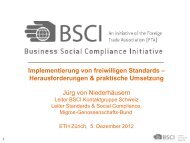Fostering Corporate Responsibility through Self- and Co-regulation
Fostering Corporate Responsibility through Self- and Co-regulation
Fostering Corporate Responsibility through Self- and Co-regulation
Create successful ePaper yourself
Turn your PDF publications into a flip-book with our unique Google optimized e-Paper software.
6. Recommendations for policymakers<br />
6. Recommendations for policymakers<br />
Through sector-specific initiatives, policymakers<br />
can foster public-private collaboration <strong>and</strong><br />
thereby enable the creation of new governance<br />
instruments that help address societal problems.<br />
Based on the five success factors we indentified<br />
<strong>and</strong> the empirical evaluation of the<br />
cases in this study, we have defined several<br />
steps that policymakers can take in order to increase<br />
the performance of self- <strong>and</strong> co-<strong>regulation</strong><br />
<strong>through</strong> sector-specific initiatives. However,<br />
these can also be helpful to other stakeholders,<br />
such as business <strong>and</strong> trade associations or individual<br />
companies, that are actively involved in<br />
developing <strong>and</strong> managing such initiatives.<br />
Help sector-specific CR grow<br />
strong roots<br />
One of the central preconditions for the success<br />
of self- <strong>and</strong> co-<strong>regulation</strong> in general is the degree<br />
to which they are institutionalised or, in other<br />
words, embedded within political structures <strong>and</strong><br />
processes. The same holds true for sector-specific<br />
initiatives. Therefore, in order to promote<br />
self- <strong>and</strong> co-<strong>regulation</strong> <strong>through</strong> sector-specific<br />
CR, the first thing public actors could do is establish<br />
such governance mechanisms in order to<br />
help them grow strong institutional roots.<br />
might be advisable. Secondly, public actors<br />
can set up intermediary institutions to serve as<br />
hubs for public-private collaboration at the sectoral<br />
level. Thirdly, they can integrate sectorspecific<br />
clauses <strong>and</strong> measures into economic<br />
<strong>and</strong> CR strategies as well as (co-)develop strategies<br />
for particular sectors.<br />
Focus on solutions<br />
Another thing that public actors can do to promote<br />
self- <strong>and</strong> co-<strong>regulation</strong> is to consider the<br />
appropriate type of public-private collaboration<br />
with regard to the problem to be solved.<br />
As demonstrated above, although there are<br />
four general types of sector-specific initiatives,<br />
these vary widely in terms of their specific<br />
goals <strong>and</strong> rationales. Likewise, each type has<br />
certain performance-related strengths <strong>and</strong> limitations<br />
in terms of their legitimacy, effectiveness<br />
<strong>and</strong> efficiency. Therefore, especially in<br />
public-led or jointly launched initiatives, public<br />
actors can make sure that they have a say<br />
in choosing the type of initiatives that is best<br />
suited to solve the particular societal problem.<br />
Stay involved <strong>through</strong><br />
the entire process<br />
As can be seen in the Appendix, governments<br />
across Europe have been practicing three institutional<br />
approaches to sector-specific CR:<br />
evolutionary, intermediary <strong>and</strong> strategic (Box<br />
A1). Regarding the first, public actors can promote<br />
sector-specific CR by practicing new governance<br />
<strong>through</strong> public institutions (e.g., ministries<br />
or regulatory agencies) or by creating<br />
multi-stakeholder institutions (e.g., forums or<br />
working groups) in which public actors are one<br />
among several stakeholders. As organisational<br />
backbone is regarded as essential for increasing<br />
social impact, 26 creating such institutions<br />
Public actors can contribute to the success of<br />
self- <strong>and</strong> co-<strong>regulation</strong> by assuming appropriate<br />
roles in such structures <strong>and</strong> processes.<br />
While the roles public actors perform often depend<br />
on the initiative’s type, we identified two<br />
roles that can particularly advance good performance<br />
of sector-specific initiatives: facilitating<br />
<strong>and</strong> managing. On the one h<strong>and</strong>, initiatives<br />
(co-)launched by public actors perform better<br />
than those that public actors joined at a later<br />
stage. On the other, having public actors steer<br />
<strong>and</strong> monitor sector-specific initiatives increases<br />
their chances of success.<br />
24














